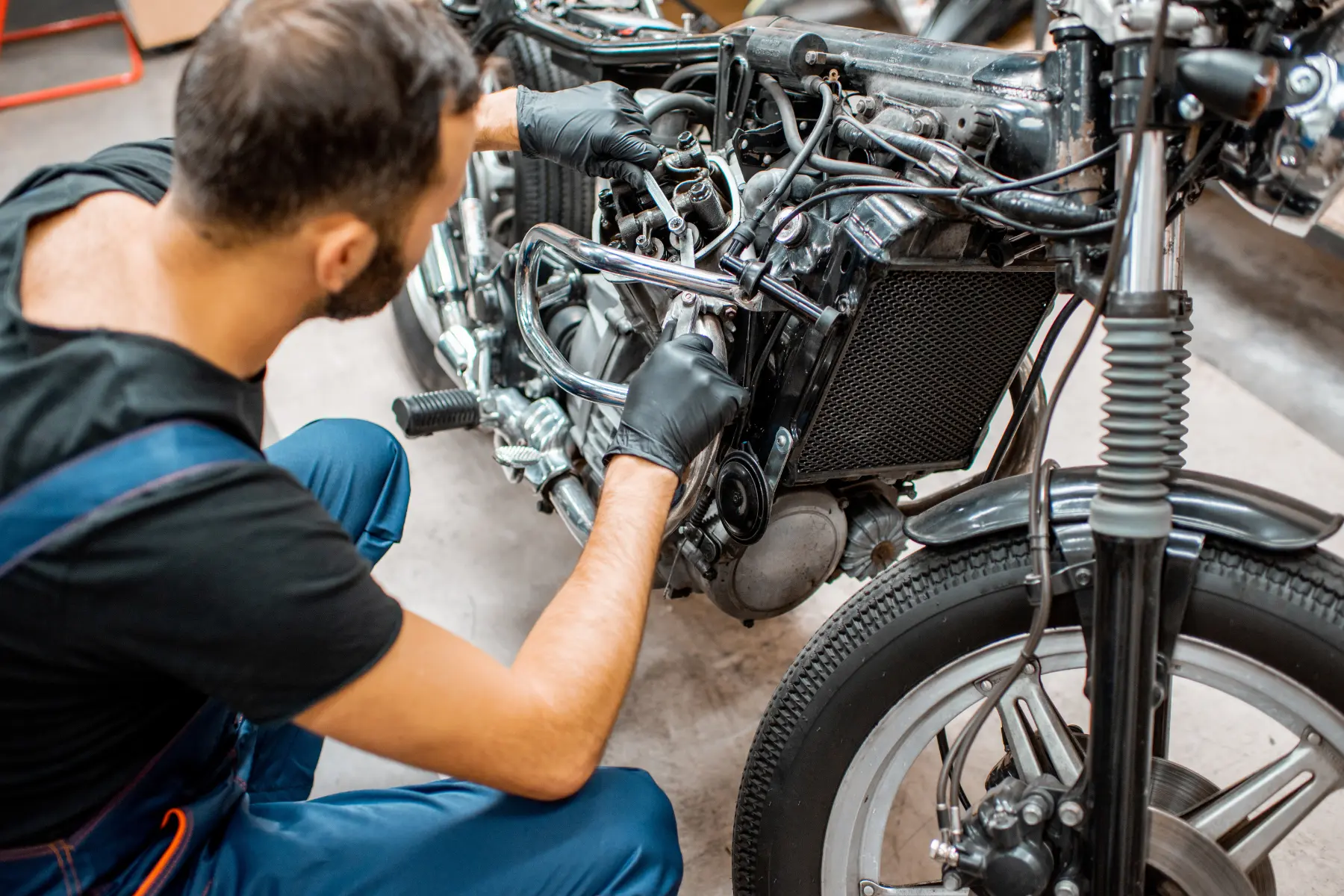About JC Whitney Editorial Team

Meet the JC Whitney Editorial Team, your go-to experts for automotive insights, from in-depth car culture articles to the latest in vehicle tech.
More from JC Whitney Editorial TeamKeeping a motorcycle in top-notch condition is crucial not just for the longevity of your ride but also for your safety on the road. Regular maintenance ensures that every part of your motorcycle functions as it should, reducing the risk of breakdowns and accidents. Just like we need regular health check-ups to stay in good shape, motorcycles require consistent care and attention to perform at their best. This care involves everything from simple cleaning routines to more complex engine checks, all aimed at ensuring your motorcycle remains reliable, safe, and enjoyable to ride.
Motorcycle Cleaning Tips
Basics of Effective Motorcycle Cleaning
Motorcycle cleaning tips are essential for any rider wanting to keep their bike looking as good as it runs. Regular cleaning does more than make your motorcycle shine; it’s a crucial part of maintenance that helps you spot any potential issues before they become serious. Start with a gentle rinse to remove loose dirt and debris, then use a soft sponge or cloth to clean every surface. Be thorough but gentle to avoid scratching the paint or damaging delicate parts.
Choosing the Right Cleaning Products
Selecting the right cleaning products is crucial to protect your motorcycle’s finish and ensure it looks its best. Ensuring your motorcycle maintains its gleam and integrity involves a careful selection of cleaning agents:
- Avoid Harsh Chemicals: Choosing the right cleaning products for your motorcycle is crucial in preserving its aesthetic and structural integrity. Harsh chemicals, often found in generic cleaning solutions, can lead to the deterioration of paint and the corrosion of metal parts. It’s important to read labels and avoid products containing strong solvents or acids that can strip away protective coatings.
- Motorcycle-Specific Products: These specialized cleaners are formulated to effectively cut through dirt, oil, and grime that motorcycles commonly collect, without compromising the integrity of paint, chrome, or other finishes. Using products designed specifically for motorcycles ensures that cleaning contributes to the vehicle’s maintenance, rather than its degradation.
By carefully selecting the right cleaning products, you safeguard your motorcycle’s luster and structural health, ensuring it shines brilliantly and stays in pristine condition for the foreseeable future, preserving its beauty and integrity.
Areas to Focus on During Cleaning
Pay special attention to areas like the wheels, chain, and under the seat where dirt and grime accumulate. These areas are not just important for aesthetics but are crucial for your motorcycle’s performance and safety. Cleaning these parts regularly prevents build-up that can lead to wear and tear or even damage. It’s also a good opportunity to inspect these areas for any issues that may need addressing.
Clutch Adjustment for Optimal Performance
Understanding Clutch Functionality
The clutch is a critical component of your motorcycle, allowing you to smoothly engage and disengage the engine from the drivetrain. Proper clutch adjustment ensures that this transition is seamless, providing a better riding experience. An improperly adjusted clutch can lead to hard shifts, increased wear on the transmission, and a lack of control, which is why understanding and maintaining your clutch is crucial for any rider.
Step-by-Step Guide to Adjusting Your Clutch
Adjusting the clutch on your motorcycle can significantly enhance your riding experience by ensuring smoother gear shifts and more responsive control. Here’s a detailed guide:
- Locate Clutch Cable and Adjuster: Begin by consulting your motorcycle’s manual to identify the location of the clutch cable and adjuster. This is crucial as the configuration can vary significantly between different models and manufacturers. Properly locating these components is the first step toward a successful adjustment.
- Loosen the Locknut: Once you have located the clutch cable adjuster, the next step involves using the appropriate tools (usually a wrench or a pair of pliers) to carefully loosen the locknut. This nut secures the adjuster in place, and loosening it allows you to modify the cable tension.
- Adjust Tension: With the locknut loosened, you can now turn the adjuster. This is done by either rotating it clockwise to increase tension or counterclockwise to decrease it. Finding the ideal balance between excessive slack and rigidity in the lever and smooth clutch engagement and disengagement is the goal here.
- Test for Engagement and Disengagement: After adjusting, it’s crucial to test the clutch’s operation. The goal is to ensure that the clutch engages and disengages cleanly and smoothly, with the lever feeling responsive and easy to operate. This step might require several adjustments to find the ideal setting.
- Consult Your Manual: Throughout this process, it’s essential to refer to your motorcycle’s manual for specific instructions and guidelines. Each model may have unique requirements or adjustment steps that are critical for proper clutch function and rider safety.
By following these detailed steps with patience and attention to detail, you can achieve a clutch adjustment motorcycle that contributes to a more enjoyable and safer riding experience. This maintenance task not only improves performance but also extends the lifespan of your motorcycle’s clutch system.
Signs Your Clutch Needs Adjustment
Common signs that your clutch adjustment is needed include a slipping clutch, difficulty shifting gears, or a clutch lever that feels either too loose or too tight. These symptoms can affect your motorcycle’s performance and your safety on the road, making it important to address them promptly. Regular checks and adjustments will keep your clutch in good working order and enhance your riding experience.
Selecting the Right Motorcycle Engine Oil
The Role of Engine Oil in Motorcycle Health
It lubricates moving parts, reduces friction, helps disperse heat, and can even help clean the engine internals. The right engine oil ensures that your motorcycle’s engine runs smoothly, remains cool during operation, and experiences less wear over time. Regular oil changes and using the correct type of oil are fundamental aspects of motorcycle maintenance that can significantly impact your bike’s longevity.
Types of Motorcycle Engine Oils
There are mainly three types of motorcycle engine oil. Choosing the right engine oil is crucial for the performance and longevity of your motorcycle. Here are the key types of oils to consider:
- Mineral Oil: The traditional choice for engine lubrication, mineral oil is extracted directly from crude oil and undergoes minimal refinement. Ideal for vintage or low-performance motorcycles, it provides basic protection against engine wear. However, its viscosity can fluctuate with temperature changes, necessitating more frequent oil changes to maintain engine health.
- Semi-Synthetic Oil: A blend that combines the cost-effectiveness of mineral oil with some of the performance benefits of synthetic oil. With typically 30% to 50% synthetic content, semi-synthetic oil offers improved protection and stability over mineral oil, making it a good middle-ground choice for riders who seek a balance between performance and affordability. It’s well-suited for a broad range of motorcycles, enhancing engine cleanliness and thermal resistance without the premium cost of fully synthetic options.
- Full Synthetic Oil: Engineered for the highest performance and protection, full synthetic oil uses chemically modified petroleum and other high-quality materials to offer superior lubrication. It excels in extreme conditions, maintaining its viscosity across a broad temperature range and reducing engine wear significantly. Although it comes at a higher upfront cost, full synthetic oil can provide long-term savings through extended oil change intervals, improved fuel efficiency, and enhanced engine longevity.
Understanding the differences between these oil types can help you make an informed decision that matches your motorcycle’s needs and your riding style. By carefully selecting the right engine oil, you ensure that your motorcycle operates smoothly, efficiently, and remains reliable over time, enhancing your riding experience and safeguarding your investment.
When to Change Your Engine Oil
The frequency of oil changes can vary based on the type of oil used, your riding habits, and the manufacturer’s recommendations. Typically, it’s advised to change the oil every 3,000 to 5,000 miles. However, always refer to your motorcycle’s manual for the most accurate guidance. Regular oil changes not only extend the life of your engine but also ensure that your motorcycle continues to perform at its best.
Impact of Oil Quality on Engine Performance
High-quality oils offer better protection against wear, more efficient heat dissipation, and improved engine cleanliness. They can also enhance fuel efficiency and make your motorcycle run smoother. Investing in premium engine oil is investing in the health of your motorcycle, ensuring that it delivers optimal performance ride after ride.
Brake Pad Maintenance and Replacement
The Importance of Brake Pads for Safety
They are responsible for creating the friction that slows down and stops your motorcycle. Worn-out brake pad motorcycle components can significantly increase stopping distances, putting you and others at risk. Regular inspection and maintenance of your brake pads ensure that they are always in good condition.
How to Replace Brake Pads
Replacing brake pads is a maintenance task that many riders can perform with basic tools. The process involves removing the wheel and caliper, replacing the old pads with new ones, and then reassembling everything. After replacing your brake pads, always test your brakes at low speeds to ensure they’re working properly before heading out on the road.
Tips for Extending Brake Pad Life
To extend the life of your brake pads, practice smooth and gradual braking rather than abrupt stops. Avoid riding in conditions that can lead to excessive brake pad wear, such as in heavy traffic or on steep, winding roads. Regular cleaning of your brake components can also prevent dirt and debris from causing premature wear. By caring for your brake pads, you can ensure they last longer and keep you safe on your rides.
Maintaining the Motorcycle Fuel System
Components of the Motorcycle Fuel System
The motorcycle fuel system plays a crucial role in delivering fuel from the tank to the engine, ensuring your bike runs smoothly and efficiently. Key components include the fuel tank, fuel pump, fuel filter, and carburetor or fuel injectors, depending on your motorcycle’s design. Regular maintenance of these components is essential to prevent issues such as clogs, leaks, and inefficiency.
Troubleshooting Fuel System Issues
If you encounter problems like difficulty starting, poor performance, or irregular idling, your motorcycle fuel system may need attention. These symptoms can indicate issues such as clogged fuel lines, dirty filters, or malfunctioning injectors/carburetors. Diagnosing and addressing these issues early can prevent more significant problems down the line.
Comprehensive Motorcycle Maintenance Guide
Exhaust System Maintenance
Maintaining your exhaust system motorcycle is crucial for performance, safety, and compliance with noise and emissions regulations. Regular inspections can help identify rust, holes, or other damage that could affect performance and safety. Keeping the exhaust system clean and free from obstructions ensures it functions correctly.
Valve Inspection and Adjustment
Valve inspection motorcycle and adjustment are critical for keeping your engine running smoothly and efficiently. Over time, valves can become misadjusted, leading to performance issues, increased fuel consumption, and engine damage. Regular checks and adjustments, as specified in your motorcycle’s maintenance schedule, ensure that valves open and close correctly, maintaining optimal engine performance.
Winterizing Your Motorcycle
Winterizing your motorcycle is essential for riders who live in climates where winter means putting the bike away for a few months. Steps include adding a fuel stabilizer, changing the oil, disconnecting the battery, and properly inflating the tires to prevent flat spots. Taking the time to prepare the motorcycle for storage ensures that it will be ready to ride when spring arrives. A motorcycle maintenance schedule plan is your roadmap to keeping your bike in top condition.
In conclusion, planning for long-term maintenance and care is the key to a trouble-free riding experience. Investing time and effort into regular maintenance tasks, and adhering to a comprehensive motorcycle maintenance guide, pays off in the long run. Not only does it keep your motorcycle in peak condition, but it also enhances your riding experience, ensuring that every journey is as enjoyable and safe as possible.
